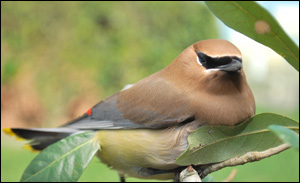 Spring is one of the most exciting times in my backyard and in the birding world in general. Migration begins in March, when the birds who have wintered south of the border begin the trip back to their summer breeding and nesting grounds in North America.
Spring is one of the most exciting times in my backyard and in the birding world in general. Migration begins in March, when the birds who have wintered south of the border begin the trip back to their summer breeding and nesting grounds in North America.
It isn’t uncommon during the latter part of March and well into April for me to see many different species of warbler, vireo, and other birds either passing through or returning to my neighborhood to stake out their territory.
During spring migration, the birds take the shortest route in order to arrive on the breeding grounds in a timely fashion. Once they start across the Gulf of Mexico, other than offshore oil rigs, there aren’t many opportunities to stop and rest. In good weather, the trip is a major undertaking. If the birds encounter a strong north wind, it makes the journey much harder, resulting in exhaustion by the time they reach the Gulf coast states of the U.S.
In a situation like that, the birds will drop down into the first trees they come across in order to rest and recuperate so they can continue their journey. Water is an especially important commodity for these birds as they regain their strength. On Sunday night, the 11th, a cold front moved down through the state and cleared our area about midnight, dropping the temps into the upper 40s and leaving behind about an inch of rain. Monday, the 12th, saw a spectacular array of migrating birds in my backyard and the surrounding area. Some were easier to identify than others.
Birding by Ear
When identifying birds in the spring after the trees have leafed out, a good skill to have is “birding by ear.” All that means is being able to hear a bird’s song and know what bird it is without seeing the bird. The trees in my yard have fully leafed out at this point. Warblers especially like to flit around among the branches of the trees, picking off insects. It is quite difficult at times to get a really good look at the flitting bird, but if he will sing, I have a good chance of figuring out just who has come to visit.
On Monday, I was able to identify the following birds by song and/or visual sighting: Northern Parula; Prairie Warbler; Hooded Warbler; Ruby-crowned Kinglet; Magnolia Warbler; Wilson’s Warbler; Pine Warbler; Orange-crowned Warbler; Black-throated Green Warbler; and Yellow-rumped Warbler. This was by far the most warbler species I’d ever seen in one day on our property. I also got good looks at Red-eyed Vireo, White-eyed Vireo, Cedar Waxwings, Ruby-throated Hummingbirds, and the first ever Broad-winged Hawk to visit our yard. I was only able to find him, because I heard him call twice to alert me he was in the area! I knew him before I saw him. What an amazing day, but probably the best was yet to come!
About an hour before sundown, I noticed that the Cedar Waxwings had begun to settle into two small trees in the yard. Each bird made a little dark spot in the upper part of the tree. I could tell they weren’t foraging, so I made the assumption they were going to roost. These birds must live by the old adage of “early to bed, early to rise, makes a birdie healthy, wealthy and wise.” Perhaps they also have heard the one about the early bird getting the worm! I got my binoculars and checked it out a bit closer. Each bird, in his own little clump of leaves, bent their beautiful yellow-tipped tails at about a 90-degree angle as if for balance. Each one also tucked its little face into a leaf or two as if to shut out the light or to rest their heads on a soft pillow, and there they remained until very early the next morning.
All day, and especially watching the Waxwings go to roost, I had the distinct sensation of the sense of awe a child must feel when watching the miracles of nature unfold in front of her. Where better to experience those miracles than right in my own backyard.
About the author: Samet Bilir writes about gardening, book reviews, holiday shopping and a lot of other things, such as butterfly and hummingbird garden. To read more articles from Samet, click here.
Credits: Photo courtesy of Josh Henderson.